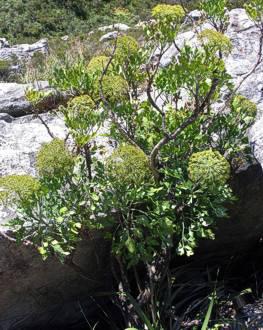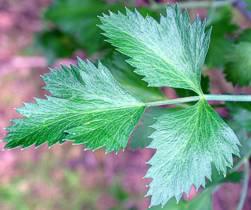Notobubon galbanum
Notobubon galbanum (L.) Magee
Family: Apiaceae
Common names: blister bush (Eng.); bergseldery, wilde seldery, droëdas (Afr.)
Introduction
Notobubon galbanum is an evergreen shrub renowned for causing severe blistering of human skin when touched. It is also a well known Cape medicinal plant.

Description
Description
Notobubon galbanum is a woody evergreen shrub growing to 2.5 m in height. The compound leaves are arranged along the upper parts of the branches and consist of toothed, rhomboidal and occasionally three-lobed leaflets that are green above and glaucous below.

The flowers are small and yellow and borne in large, rounded compound umbels on a relatively short peduncle. The fruit is dry and dorsally flattened with narrow wings along the margins. Flowering time is from October to February.

Conservation Status
Status
Least Concern (LC)
Distribution and habitat
Distribution description
The species is widespread in moist fynbos vegetation from Elands Bay to the Cape Peninsula and east to the Langeberg Mountains in the Western Cape Province of South Africa.
Derivation of name and historical aspects
History
The species of Notobubon were previously placed within the large predominantly Eurasian genus Peucedanum L. However, recent studies of the African Peucedanum species (Winter et al. 2008) revealed that they were not related to their supposed Eurasian relatives and were therefore separated into six African endemic genera, namely Afroligusticum C. Norman, Afrosciadium P.J.D. Winter, Cynorhiza Eckl. & Zeyh., Lefebvrea A.Rich., Nanobubon Magee, and Notobubon B.E-van Wyk. The twelve currently recognized species of Notobubon can be distinguished from the previously mentioned African genera by their shrubby habit, permanent woody branches, evergreen leathery leaves and smaller fruit.
The root of the name Notobubon reflects the fact that many of the species of this genus were once part of the genus Bubon L. (see e.g. Sonder 1862).The Greek prefix "noto" means southern and alludes to the genus's southern African origin (Magee et al. 2009). The specific epithet, "galbanum" indicates that at the time of its description this species was erroneously considered to be the species from which one of the oldest recorded medicines, galbanum, was obtained.
Ecology
Ecology
The flowers of Notobubon galbanum attract a wide range of insect visitors and the plant is also a host to the citrus swallowtail, Papilio demodocus (Kroon, 1999). Notobubon galbanum is probably best known for causing severe blistering of human skin, hence the common name 'blisterbush' (Smith 1966). This phototoxic condition manifests only several hours after contact with the leaves (Van Wyk et al. 2002) and is due to a reaction between the furanocoumarins of the plant and the DNA of the skin that occurs in the presence of sunlight. As mentioned by Marloth (1925) the blistering effect of N. galbanum is quite variable. This variation may depend on the extent of tissue damage to the plant (i.e. from herbivores), as well as the subsequent degree of exposure of the affected skin to sunlight.

The fruits are also unusual in that the seed is surrounded by an almost continuous ring of oil canals, called vittae (indicated by arrows in the figure below which shows a fruit in transverse section). These canals contain phenolic compounds, including coumarins, and probably serve to protect the nutrient-rich seed from insect damage.

Uses
Use
Notobubon galbanum is a well-known Cape medicinal plant whose ethnobotanical uses have been well documented (Dykman 1891, Kling 1923, Marloth 1925, Pappe 1857, Rood 1994,; Van Wyk et al. 1997 and Watt & Breyer-Brandwijk 1962). It has been recorded primarily as a remedy for rheumatism, gout, bladder ailments, water retention and high blood pressure. Pappe (1857), a medical doctor interested in plants, recorded "wilde seldery" as being "reputed amongst the inhabitants as an excellent diuretic", while Dykman (1891), in her South African recipe book, recommends a brandy tincture of the leaves for treating obesity in men. Watt & Breyer-Brandwijk (1962) record that it is also used as a diuretic and in combination with Diosma hirsuta L. for the treatment of dropsy and renal diseases, or with Mentha longifolia Huds. and Pelargonium grossularioides (L.) L'Hér. for the suppression of menses. Van Wyk et al. (1997) add that an infusion together with Chironia spp. is used as a remedy against rheumatism.
Growing Notobubon galbanum
Grow
Specific information regarding the cultivation of N. galbanum is currently unavailable. However, details for Peucedanum polyactinum B.L.Burtt [now Notobubon capense (Eckl. & Zeyh.) Magee] provided by Forrester (2006) are likely to be applicable to this species as well. The plant is probably best placed in sun or semi-shade, near the back of the herbaceous bed. Due to the phototoxicity of the leaves care should be taken to plant it in an area where unnecessary contact with the leaves is minimized (and of course also while handling it during planting). The bold leathery discolorous leaves and structurally striking and the large compound umbels make this shrub an appealing garden subject.
References
- Dykman, E.J. 1891. Kook-, Koek- en Resepte Boek. Paarl: Paarlse Drukpers Maatskappy.
- Forrester, J. 2006-08. Peucedanum polyactinum B.L.Burtt. Internet 4 pp. http://www.plantzafrica.com/plantnop/peucedpoly.htm.
- Kling, H. 1923. Die Sieketrooster. Van de Sandt, de Villiers and Co., Cape Town.
- Kroon, D.M. 1999. Lepidoptera of Southern Africa. Host-plants and other associations. A catalogue. Lepidopterists' Society of Africa, South Africa.
- Magee, A.R., Van Wyk, B.-E. & Tilney, P.M. 2009. A taxonomic revision of the woody South African genus Notobubon (Apiaceae: Apioideae). Systematic Botany 34: 220-242.
- Marloth, R. 1925. The flora of South Africa : with synoptical tables of the genera of the higher plants 2. Darter Bros. and Co., Cape Town.
- Pappe, L. 1857. Florae capensis medicae prodromus,. edn 2. Cape Town.
- Rood, B. 1994. Uit die veldapteek. Tafelberg, Cape Town.
- Smith, C.A. 1966. Common names of South African plants. Memoirs of the Botanical Survey of South Africa 35. Department of Agricultural Technical Services, Pretoria.
- Sonder, O.W. 1862. Umbelliferae. Flora Capensis 2: 524-567. Harvey, W.H. & Sonder, O.W. (eds). Hodges Smith, Dublin.
- Van Wyk, B.-E., Van Oudtshoorn, B. & Gericke, N. 1997. Medicinal plants of South Africa. Briza Publications, Pretoria.
- Van Wyk, B.-E., Van Heerden, F. & Van Oudtshoorn, B. 2002. Poisonous plants of South Africa. Briza Publications, Pretoria.
- Watt, J.M. & Breyer-Brandwijk, M.G. 1962. The medicinal and poisonous plants of Southern and Eastern Africa, edn 2. Livingstone, London.
- Winter, P.J.D., Magee, A.R., Phephu, N., Tilney, P.M., Downie, S.R. & Van Wyk, B.-E. 2008. A new generic classification for African peucedanoid species (Apiaceae). Taxon 57 (2): 347-364.
Credits
Anthony R. Magee
Compton Herbarium
April 2010
Plant Attributes:
Plant Type: Perennial, Shrub
SA Distribution: Western Cape
Soil type: Loam
Flowering season: Early Summer, Late Summer
PH: Acid
Flower colour: Yellow
Aspect: Full Sun
Gardening skill: Easy
Special Features:
Horticultural zones








Rate this article
Article well written and informative
Rate this plant
Is this an interesting plant?
Login to add your Comment
Back to topNot registered yet? Click here to register.